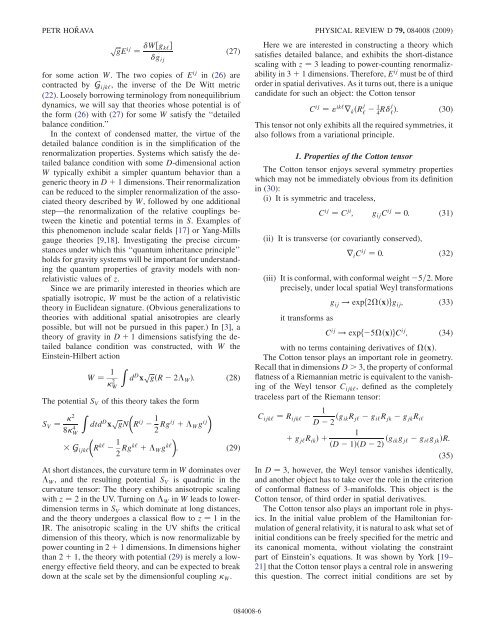Quantum gravity at a Lifshitz point
Quantum gravity at a Lifshitz point
Quantum gravity at a Lifshitz point
Create successful ePaper yourself
Turn your PDF publications into a flip-book with our unique Google optimized e-Paper software.
PETR HOŘAVA PHYSICAL REVIEW D 79, 084008 (2009)pffiffiffig E ij ¼ W½g k‘Š(27)g ijfor some action W. The two copies of E ij in (26) arecontracted by G ijk‘ , the inverse of the De Witt metric(22). Loosely borrowing terminology from nonequilibriumdynamics, we will say th<strong>at</strong> theories whose potential is ofthe form (26) with (27) for some W s<strong>at</strong>isfy the ‘‘detailedbalance condition.’’In the context of condensed m<strong>at</strong>ter, the virtue of thedetailed balance condition is in the simplific<strong>at</strong>ion of therenormaliz<strong>at</strong>ion properties. Systems which s<strong>at</strong>isfy the detailedbalance condition with some D-dimensional actionW typically exhibit a simpler quantum behavior than ageneric theory in D þ 1 dimensions. Their renormaliz<strong>at</strong>ioncan be reduced to the simpler renormaliz<strong>at</strong>ion of the associ<strong>at</strong>edtheory described by W, followed by one additionalstep—the renormaliz<strong>at</strong>ion of the rel<strong>at</strong>ive couplings betweenthe kinetic and potential terms in S. Examples ofthis phenomenon include scalar fields [17] or Yang-Millsgauge theories [9,18]. Investig<strong>at</strong>ing the precise circumstancesunder which this ‘‘quantum inheritance principle’’holds for <strong>gravity</strong> systems will be important for understandingthe quantum properties of <strong>gravity</strong> models with nonrel<strong>at</strong>ivisticvalues of z.Since we are primarily interested in theories which aresp<strong>at</strong>ially isotropic, W must be the action of a rel<strong>at</strong>ivistictheory in Euclidean sign<strong>at</strong>ure. (Obvious generaliz<strong>at</strong>ions totheories with additional sp<strong>at</strong>ial anisotropies are clearlypossible, but will not be pursued in this paper.) In [3], <strong>at</strong>heory of <strong>gravity</strong> in D þ 1 dimensions s<strong>at</strong>isfying the detailedbalance condition was constructed, with W theEinstein-Hilbert actionW ¼ 1 2 WZd D px ffiffiffi g ðR 2W Þ: (28)The potential S V of this theory takes the formS V ¼ 28 4 WZdtd D x ffiffiffipg NR ij 12 Rgij þ W g ij G ijk‘ R k‘ 12 Rgk‘ þ W g k‘ : (29)At short distances, the curv<strong>at</strong>ure term in W domin<strong>at</strong>es over W , and the resulting potential S V is quadr<strong>at</strong>ic in thecurv<strong>at</strong>ure tensor: The theory exhibits anisotropic scalingwith z ¼ 2 in the UV. Turning on W in W leads to lowerdimensionterms in S V which domin<strong>at</strong>e <strong>at</strong> long distances,and the theory undergoes a classical flow to z ¼ 1 in theIR. The anisotropic scaling in the UV shifts the criticaldimension of this theory, which is now renormalizable bypower counting in 2 þ 1 dimensions. In dimensions higherthan 2 þ 1, the theory with potential (29) is merely a lowenergyeffective field theory, and can be expected to breakdown <strong>at</strong> the scale set by the dimensionful coupling W .Here we are interested in constructing a theory whichs<strong>at</strong>isfies detailed balance, and exhibits the short-distancescaling with z ¼ 3 leading to power-counting renormalizabilityin 3 þ 1 dimensions. Therefore, E ij must be of thirdorder in sp<strong>at</strong>ial deriv<strong>at</strong>ives. As it turns out, there is a uniquecandid<strong>at</strong>e for such an object: the Cotton tensorC ij ¼ " ik‘ r k ðR j 1‘ 4 Rj ‘Þ: (30)This tensor not only exhibits all the required symmetries, italso follows from a vari<strong>at</strong>ional principle.1. Properties of the Cotton tensorThe Cotton tensor enjoys several symmetry propertieswhich may not be immedi<strong>at</strong>ely obvious from its definitionin (30):(i) It is symmetric and traceless,C ij ¼ C ji ; g ij C ij ¼ 0: (31)(ii) It is transverse (or covariantly conserved),r i C ij ¼ 0: (32)(iii) It is conformal, with conformal weight 5=2. Moreprecisely, under local sp<strong>at</strong>ial Weyl transform<strong>at</strong>ionsg ij ! expf2ðxÞgg ij ; (33)it transforms asC ij ! expf 5ðxÞgC ij ; (34)with no terms containing deriv<strong>at</strong>ives of ðxÞ.The Cotton tensor plays an important role in geometry.Recall th<strong>at</strong> in dimensions D>3, the property of conformalfl<strong>at</strong>ness of a Riemannian metric is equivalent to the vanishingof the Weyl tensor C ijk‘ , defined as the completelytraceless part of the Riemann tensor:1C ijk‘ ¼ R ijk‘D 2 ðg ikR j‘ g i‘ R jk g jk R i‘1þ g j‘ R ik ÞþðD 1ÞðD 2Þ ðg ikg j‘ g i‘ g jk ÞR:(35)In D ¼ 3, however, the Weyl tensor vanishes identically,and another object has to take over the role in the criterionof conformal fl<strong>at</strong>ness of 3-manifolds. This object is theCotton tensor, of third order in sp<strong>at</strong>ial deriv<strong>at</strong>ives.The Cotton tensor also plays an important role in physics.In the initial value problem of the Hamiltonian formul<strong>at</strong>ionof general rel<strong>at</strong>ivity, it is n<strong>at</strong>ural to ask wh<strong>at</strong> set ofinitial conditions can be freely specified for the metric andits canonical momenta, without viol<strong>at</strong>ing the constraintpart of Einstein’s equ<strong>at</strong>ions. It was shown by York [19–21] th<strong>at</strong> the Cotton tensor plays a central role in answeringthis question. The correct initial conditions are set by084008-6



![arXiv:1001.0993v1 [hep-ph] 6 Jan 2010](https://img.yumpu.com/51282177/1/190x245/arxiv10010993v1-hep-ph-6-jan-2010.jpg?quality=85)


![arXiv:1008.3907v2 [astro-ph.CO] 1 Nov 2011](https://img.yumpu.com/48909562/1/190x245/arxiv10083907v2-astro-phco-1-nov-2011.jpg?quality=85)







![arXiv:1002.4928v1 [gr-qc] 26 Feb 2010](https://img.yumpu.com/41209516/1/190x245/arxiv10024928v1-gr-qc-26-feb-2010.jpg?quality=85)
![arXiv:1206.2653v1 [astro-ph.CO] 12 Jun 2012](https://img.yumpu.com/39510078/1/190x245/arxiv12062653v1-astro-phco-12-jun-2012.jpg?quality=85)
